engine coolant Seat Exeo ST 2012 User Guide
[x] Cancel search | Manufacturer: SEAT, Model Year: 2012, Model line: Exeo ST, Model: Seat Exeo ST 2012Pages: 325, PDF Size: 5.56 MB
Page 236 of 325
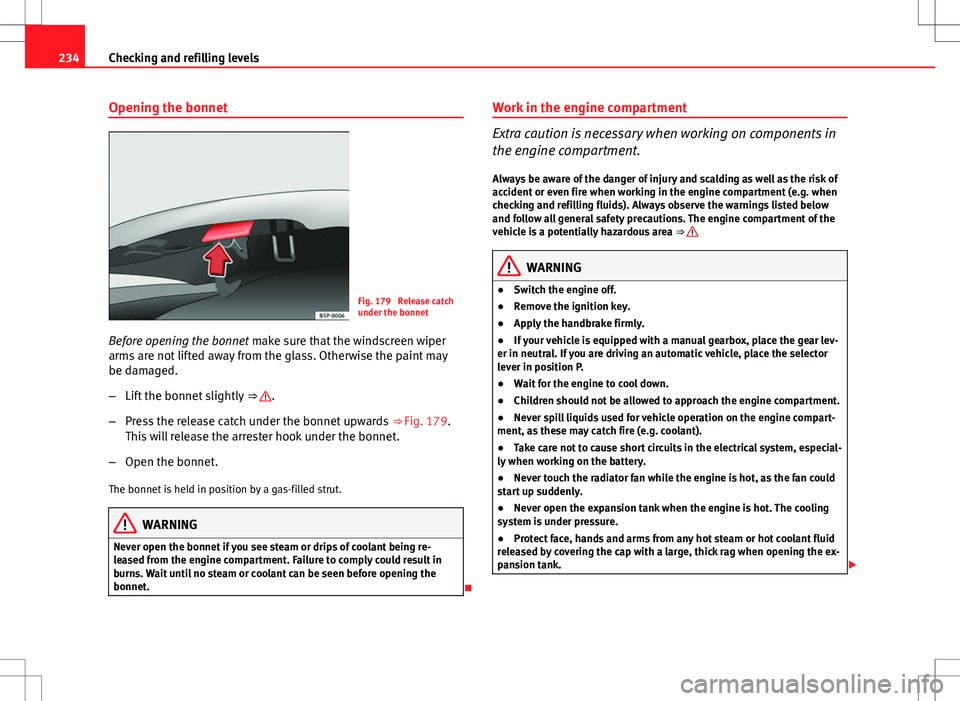
234Checking and refilling levels
Opening the bonnet
Fig. 179 Release catch
under the bonnet
Before opening the bonnet make sure that the windscreen wiper
arms are not lifted away from the glass. Otherwise the paint may
be damaged.
– Lift the bonnet slightly ⇒
.
– Press the release catch under the bonnet upwards ⇒ Fig. 179.
This will release the arrester hook under the bonnet.
– Open the bonnet.
The bonnet is held in position by a gas-filled strut.
WARNING
Never open the bonnet if you see steam or drips of coolant being re-
leased from the engine compartment. Failure to comply could result in
burns. Wait until no steam or coolant can be seen before opening the
bonnet.
Work in the engine compartment
Extra caution is necessary when working on components in
the engine compartment.
Always be aware of the danger of injury and scalding as well as the risk of
accident or even fire when working in the engine compartment (e.g. when
checking and refilling fluids). Always observe the warnings listed below
and follow all general safety precautions. The engine compartment of the
vehicle is a potentially hazardous area ⇒
WARNING
● Switch the engine off.
● Remove the ignition key.
● Apply the handbrake firmly.
● If your vehicle is equipped with a manual gearbox, place the gear lev-
er in neutral. If you are driving an automatic vehicle, place the selector
lever in position P.
● Wait for the engine to cool down.
● Children should not be allowed to approach the engine compartment.
● Never spill liquids used for vehicle operation on the engine compart-
ment, as these may catch fire (e.g. coolant).
● Take care not to cause short circuits in the electrical system, especial-
ly when working on the battery.
● Never touch the radiator fan while the engine is hot, as the fan could
start up suddenly.
● Never open the expansion tank when the engine is hot. The cooling
system is under pressure.
● Protect face, hands and arms from any hot steam or hot coolant fluid
released by covering the cap with a large, thick rag when opening the ex-
pansion tank.
Page 240 of 325
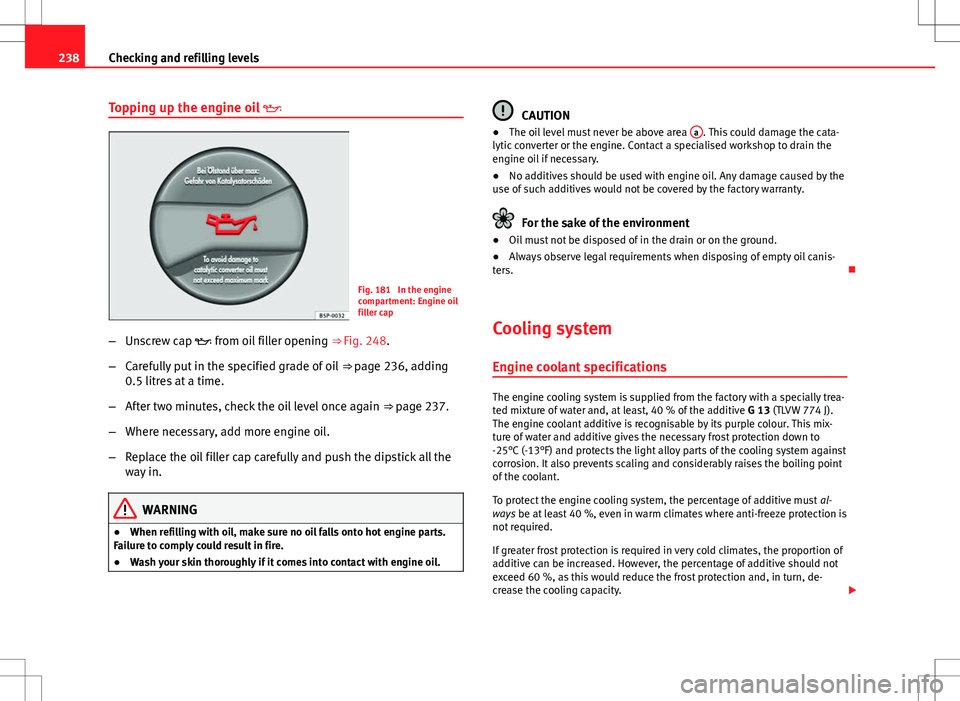
238Checking and refilling levels
Topping up the engine oil
Fig. 181 In the engine
compartment: Engine oil
filler cap
– Unscrew cap from oil filler opening ⇒ Fig. 248.
– Carefully put in the specified grade of oil ⇒ page 236, adding
0.5 litres at a time.
– After two minutes, check the oil level once again ⇒ page 237.
– Where necessary, add more engine oil.
– Replace the oil filler cap carefully and push the dipstick all the
way in.
WARNING
● When refilling with oil, make sure no oil falls onto hot engine parts.
Failure to comply could result in fire.
● Wash your skin thoroughly if it comes into contact with engine oil.
CAUTION
● The oil level must never be above area a. This could damage the cata-
lytic converter or the engine. Contact a specialised workshop to drain the
engine oil if necessary.
● No additives should be used with engine oil. Any damage caused by the
use of such additives would not be covered by the factory warranty.
For the sake of the environment
● Oil must not be disposed of in the drain or on the ground.
● Always observe legal requirements when disposing of empty oil canis-
ters.
Cooling system Engine coolant specifications
The engine cooling system is supplied from the factory with a specially trea-
ted mixture of water and, at least, 40 % of the additive G 13 (TLVW 774 J).
The engine coolant additive is recognisable by its purple colour. This mix-
ture of water and additive gives the necessary frost protection down to
-25°C (-13°F) and protects the light alloy parts of the cooling system against
corrosion. It also prevents scaling and considerably raises the boiling point
of the coolant.
To protect the engine cooling system, the percentage of additive must al-
ways be at least 40 %, even in warm climates where anti-freeze protection is
not required.
If greater frost protection is required in very cold climates, the proportion of
additive can be increased. However, the percentage of additive should not
exceed 60 %, as this would reduce the frost protection and, in turn, de-
crease the cooling capacity.
Page 241 of 325

239
Checking and refilling levels
When the coolant is topped up, use a mixture of distilled water and, at
least, 40 % of the G 13 or G 12 plus-plus (TL-VW 774 G) additive (both are
purple) to obtain an optimum anticorrosion protection ⇒
. The mixture of
G 13 with G 12 plus (TL-VW 774 F), G 12 (red) or G 11 (green-blue) engine
coolants will significantly reduce the anticorrosion protection and should,
therefore be avoided ⇒
.
WARNING
If there is not enough anti-freeze in the coolant system, the engine may
fail leading to serious damage.
● Please make sure that the percentage of additive is correct with re-
spect to the lowest expected ambient temperature in the zone in which
the vehicle is to be used.
● When the outside temperature is very low, the coolant could freeze
and the vehicle would be immobilised. In this case, the heating would
not work either and inadequately dressed passengers could die of cold.
CAUTION
The original additives should never be mixed with coolants which are not
approved by SEAT. Otherwise, you run the risk of causing severe damage to
the engine and the engine cooling system.
● If the fluid in the expansion tank is not purple but is, for example,
brown, this indicates that the G 13 additive has been mixed with an inade-
quate coolant. The coolant must be changed as soon as possible if this is
the case! This could result in serious faults and engine damage.
For the sake of the environment
Coolants and additives can contaminate the environment. If any fluids are
spilled, they should be collected and correctly disposed of, with respect to
the environment. Checking the coolant level
The coolant level can be checked visually.
Fig. 182 Engine com-
partment: Coolant fluid
deposit
– Switch the ignition off.
– Check the coolant level on coolant fluid expansion tank
⇒ Fig. 182. When the engine is cold, it should be between the
“min” and “max” marks. When the engine is hot, it may be
slightly above the “max” mark.
Its location is shown in the corresponding general overview of the engine
compartment.
The coolant level should be checked with the engine switched off.
The coolant level is monitored by a warning lamp on the instrument panel
display ⇒ page 81. However, we recommend that it should be checked oc-
casionally.
Safety FirstOperating InstructionsPractical TipsTechnical Specifications
Page 242 of 325
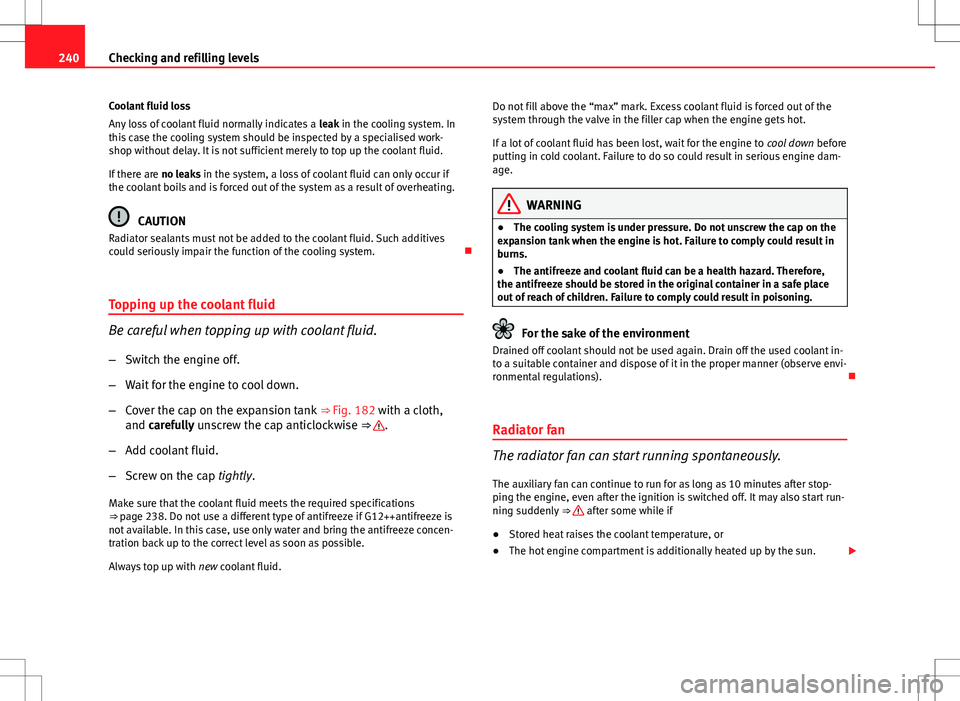
240Checking and refilling levels
Coolant fluid loss
Any loss of coolant fluid normally indicates a leak in the cooling system. In
this case the cooling system should be inspected by a specialised work-
shop without delay. It is not sufficient merely to top up the coolant fluid.
If there are no leaks in the system, a loss of coolant fluid can only occur if
the coolant boils and is forced out of the system as a result of overheating.
CAUTION
Radiator sealants must not be added to the coolant fluid. Such additives
could seriously impair the function of the cooling system.
Topping up the coolant fluid
Be careful when topping up with coolant fluid. – Switch the engine off.
– Wait for the engine to cool down.
– Cover the cap on the expansion tank ⇒ Fig. 182 with a cloth,
and carefully unscrew the cap anticlockwise ⇒
.
– Add coolant fluid.
– Screw on the cap tightly.
Make sure that the coolant fluid meets the required specifications
⇒ page 238. Do not use a different type of antifreeze if G12++antifreeze is
not available. In this case, use only water and bring the antifreeze concen-
tration back up to the correct level as soon as possible.
Always top up with new coolant fluid. Do not fill above the “max” mark. Excess coolant fluid is forced out of the
system through the valve in the filler cap when the engine gets hot.
If a lot of coolant fluid has been lost, wait for the engine to
cool down before
putting in cold coolant. Failure to do so could result in serious engine dam-
age.
WARNING
● The cooling system is under pressure. Do not unscrew the cap on the
expansion tank when the engine is hot. Failure to comply could result in
burns.
● The antifreeze and coolant fluid can be a health hazard. Therefore,
the antifreeze should be stored in the original container in a safe place
out of reach of children. Failure to comply could result in poisoning.
For the sake of the environment
Drained off coolant should not be used again. Drain off the used coolant in-
to a suitable container and dispose of it in the proper manner (observe envi-
ronmental regulations).
Radiator fan
The radiator fan can start running spontaneously. The auxiliary fan can continue to run for as long as 10 minutes after stop-
ping the engine, even after the ignition is switched off. It may also start run-
ning suddenly ⇒
after some while if
● Stored heat raises the coolant temperature, or
● The hot engine compartment is additionally heated up by the sun.
Page 306 of 325
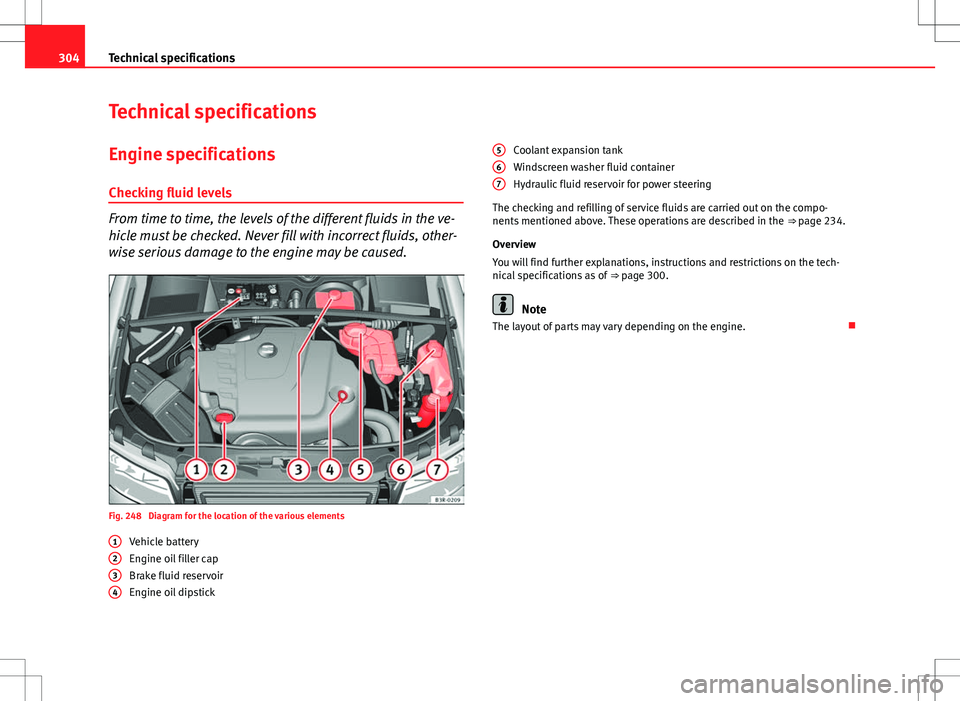
304Technical specifications
Technical specifications
Engine specifications Checking fluid levels
From time to time, the levels of the different fluids in the ve-
hicle must be checked. Never fill with incorrect fluids, other-
wise serious damage to the engine may be caused.
Fig. 248 Diagram for the location of the various elements Vehicle battery
Engine oil filler cap
Brake fluid reservoir
Engine oil dipstick
1
234
Coolant expansion tank
Windscreen washer fluid container
Hydraulic fluid reservoir for power steering
The checking and refilling of service fluids are carried out on the compo-
nents mentioned above. These operations are described in the ⇒ page 234.
Overview
You will find further explanations, instructions and restrictions on the tech-
nical specifications as of ⇒ page 300.
Note
The layout of parts may vary depending on the engine.
567
Page 316 of 325
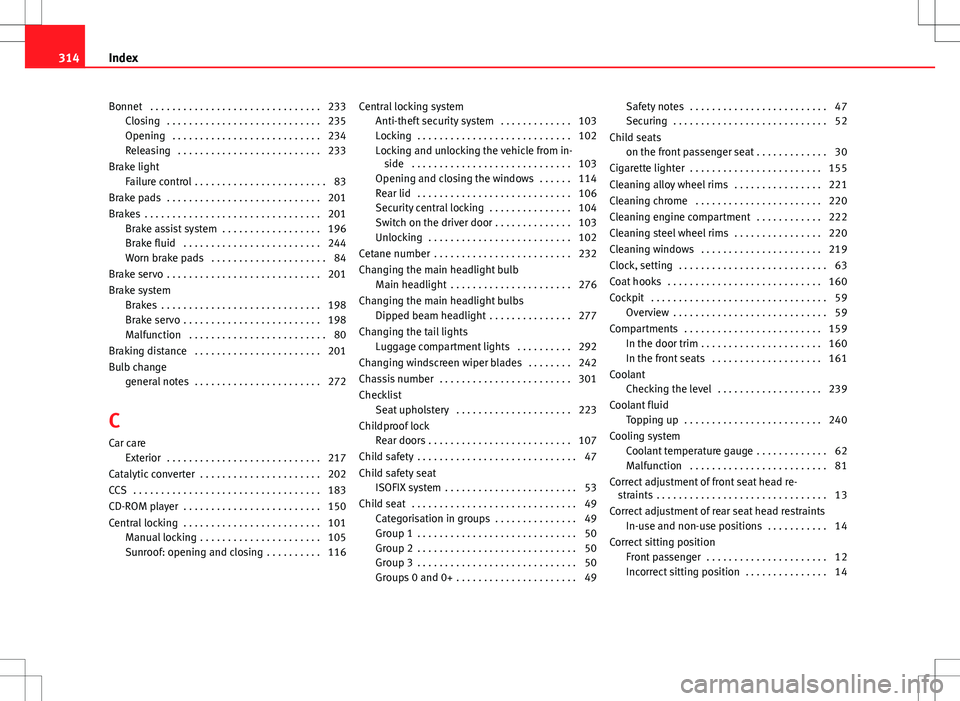
Bonnet . . . . . . . . . . . . . . . . . . . . . . . . . . . . . . . 233Closing . . . . . . . . . . . . . . . . . . . . . . . . . . . . 235
Opening . . . . . . . . . . . . . . . . . . . . . . . . . . . 234
Releasing . . . . . . . . . . . . . . . . . . . . . . . . . . 233
Brake light Failure control . . . . . . . . . . . . . . . . . . . . . . . . 83
Brake pads . . . . . . . . . . . . . . . . . . . . . . . . . . . . 201
Brakes . . . . . . . . . . . . . . . . . . . . . . . . . . . . . . . . 201 Brake assist system . . . . . . . . . . . . . . . . . . 196
Brake fluid . . . . . . . . . . . . . . . . . . . . . . . . . 244
Worn brake pads . . . . . . . . . . . . . . . . . . . . . 84
Brake servo . . . . . . . . . . . . . . . . . . . . . . . . . . . . 201
Brake system Brakes . . . . . . . . . . . . . . . . . . . . . . . . . . . . . 198
Brake servo . . . . . . . . . . . . . . . . . . . . . . . . . 198
Malfunction . . . . . . . . . . . . . . . . . . . . . . . . . 80
Braking distance . . . . . . . . . . . . . . . . . . . . . . . 201
Bulb change general notes . . . . . . . . . . . . . . . . . . . . . . . 272
C
Car care Exterior . . . . . . . . . . . . . . . . . . . . . . . . . . . . 217
Catalytic converter . . . . . . . . . . . . . . . . . . . . . . 202
CCS . . . . . . . . . . . . . . . . . . . . . . . . . . . . . . . . . . 183
CD-ROM player . . . . . . . . . . . . . . . . . . . . . . . . . 150
Central locking . . . . . . . . . . . . . . . . . . . . . . . . . 101 Manual locking . . . . . . . . . . . . . . . . . . . . . . 105
Sunroof: opening and closing . . . . . . . . . . 116 Central locking system
Anti-theft security system . . . . . . . . . . . . . 103
Locking . . . . . . . . . . . . . . . . . . . . . . . . . . . . 102
Locking and unlocking the vehicle from in-side . . . . . . . . . . . . . . . . . . . . . . . . . . . . . 103
Opening and closing the windows . . . . . . 114
Rear lid . . . . . . . . . . . . . . . . . . . . . . . . . . . . 106
Security central locking . . . . . . . . . . . . . . . 104
Switch on the driver door . . . . . . . . . . . . . . 103
Unlocking . . . . . . . . . . . . . . . . . . . . . . . . . . 102
Cetane number . . . . . . . . . . . . . . . . . . . . . . . . . 232
Changing the main headlight bulb Main headlight . . . . . . . . . . . . . . . . . . . . . . 276
Changing the main headlight bulbs Dipped beam headlight . . . . . . . . . . . . . . . 277
Changing the tail lights Luggage compartment lights . . . . . . . . . . 292
Changing windscreen wiper blades . . . . . . . . 242
Chassis number . . . . . . . . . . . . . . . . . . . . . . . . 301
Checklist Seat upholstery . . . . . . . . . . . . . . . . . . . . . 223
Childproof lock Rear doors . . . . . . . . . . . . . . . . . . . . . . . . . . 107
Child safety . . . . . . . . . . . . . . . . . . . . . . . . . . . . . 47
Child safety seat ISOFIX system . . . . . . . . . . . . . . . . . . . . . . . . 53
Child seat . . . . . . . . . . . . . . . . . . . . . . . . . . . . . . 49 Categorisation in groups . . . . . . . . . . . . . . . 49
Group 1 . . . . . . . . . . . . . . . . . . . . . . . . . . . . . 50
Group 2 . . . . . . . . . . . . . . . . . . . . . . . . . . . . . 50
Group 3 . . . . . . . . . . . . . . . . . . . . . . . . . . . . . 50
Groups 0 and 0+ . . . . . . . . . . . . . . . . . . . . . . 49 Safety notes . . . . . . . . . . . . . . . . . . . . . . . . . 47
Securing . . . . . . . . . . . . . . . . . . . . . . . . . . . . 52
Child seats on the front passenger seat . . . . . . . . . . . . . 30
Cigarette lighter . . . . . . . . . . . . . . . . . . . . . . . . 155
Cleaning alloy wheel rims . . . . . . . . . . . . . . . . 221
Cleaning chrome . . . . . . . . . . . . . . . . . . . . . . . 220
Cleaning engine compartment . . . . . . . . . . . . 222
Cleaning steel wheel rims . . . . . . . . . . . . . . . . 220
Cleaning windows . . . . . . . . . . . . . . . . . . . . . . 219
Clock, setting . . . . . . . . . . . . . . . . . . . . . . . . . . . 63
Coat hooks . . . . . . . . . . . . . . . . . . . . . . . . . . . . 160
Cockpit . . . . . . . . . . . . . . . . . . . . . . . . . . . . . . . . 59 Overview . . . . . . . . . . . . . . . . . . . . . . . . . . . . 59
Compartments . . . . . . . . . . . . . . . . . . . . . . . . . 159 In the door trim . . . . . . . . . . . . . . . . . . . . . . 160
In the front seats . . . . . . . . . . . . . . . . . . . . 161
Coolant Checking the level . . . . . . . . . . . . . . . . . . . 239
Coolant fluid Topping up . . . . . . . . . . . . . . . . . . . . . . . . . 240
Cooling system Coolant temperature gauge . . . . . . . . . . . . . 62
Malfunction . . . . . . . . . . . . . . . . . . . . . . . . . 81
Correct adjustment of front seat head re- straints . . . . . . . . . . . . . . . . . . . . . . . . . . . . . . . 13
Correct adjustment of rear seat head restraints In-use and non-use positions . . . . . . . . . . . 14
Correct sitting position Front passenger . . . . . . . . . . . . . . . . . . . . . . 12
Incorrect sitting position . . . . . . . . . . . . . . . 14
314 Index
Page 318 of 325
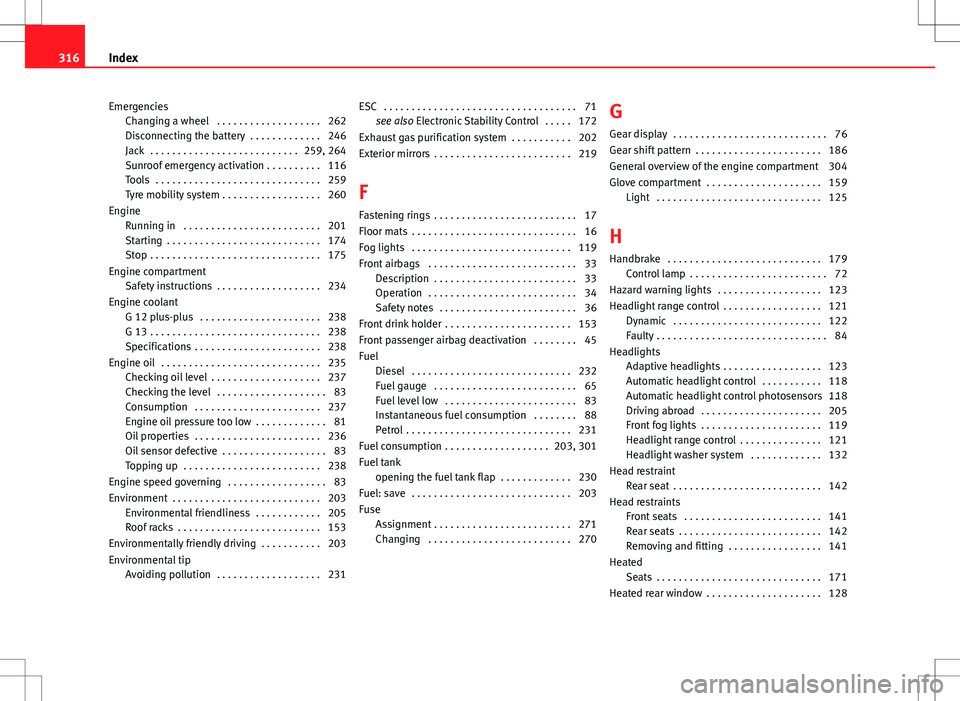
EmergenciesChanging a wheel . . . . . . . . . . . . . . . . . . . 262
Disconnecting the battery . . . . . . . . . . . . . 246
Jack . . . . . . . . . . . . . . . . . . . . . . . . . . . 259, 264
Sunroof emergency activation . . . . . . . . . . 116
Tools . . . . . . . . . . . . . . . . . . . . . . . . . . . . . . 259
Tyre mobility system . . . . . . . . . . . . . . . . . . 260
Engine Running in . . . . . . . . . . . . . . . . . . . . . . . . . 201
Starting . . . . . . . . . . . . . . . . . . . . . . . . . . . . 174
Stop . . . . . . . . . . . . . . . . . . . . . . . . . . . . . . . 175
Engine compartment Safety instructions . . . . . . . . . . . . . . . . . . . 234
Engine coolant G 12 plus-plus . . . . . . . . . . . . . . . . . . . . . . 238
G 13 . . . . . . . . . . . . . . . . . . . . . . . . . . . . . . . 238
Specifications . . . . . . . . . . . . . . . . . . . . . . . 238
Engine oil . . . . . . . . . . . . . . . . . . . . . . . . . . . . . 235 Checking oil level . . . . . . . . . . . . . . . . . . . . 237
Checking the level . . . . . . . . . . . . . . . . . . . . 83
Consumption . . . . . . . . . . . . . . . . . . . . . . . 237
Engine oil pressure too low . . . . . . . . . . . . . 81
Oil properties . . . . . . . . . . . . . . . . . . . . . . . 236
Oil sensor defective . . . . . . . . . . . . . . . . . . . 83
Topping up . . . . . . . . . . . . . . . . . . . . . . . . . 238
Engine speed governing . . . . . . . . . . . . . . . . . . 83
Environment . . . . . . . . . . . . . . . . . . . . . . . . . . . 203 Environmental friendliness . . . . . . . . . . . . 205
Roof racks . . . . . . . . . . . . . . . . . . . . . . . . . . 153
Environmentally friendly driving . . . . . . . . . . . 203
Environmental tip Avoiding pollution . . . . . . . . . . . . . . . . . . . 231 ESC . . . . . . . . . . . . . . . . . . . . . . . . . . . . . . . . . . . 71
see also Electronic Stability Control . . . . . 172
Exhaust gas purification system . . . . . . . . . . . 202
Exterior mirrors . . . . . . . . . . . . . . . . . . . . . . . . . 219
F
Fastening rings . . . . . . . . . . . . . . . . . . . . . . . . . . 17
Floor mats . . . . . . . . . . . . . . . . . . . . . . . . . . . . . . 16
Fog lights . . . . . . . . . . . . . . . . . . . . . . . . . . . . . 119
Front airbags . . . . . . . . . . . . . . . . . . . . . . . . . . . 33 Description . . . . . . . . . . . . . . . . . . . . . . . . . . 33
Operation . . . . . . . . . . . . . . . . . . . . . . . . . . . 34
Safety notes . . . . . . . . . . . . . . . . . . . . . . . . . 36
Front drink holder . . . . . . . . . . . . . . . . . . . . . . . 153
Front passenger airbag deactivation . . . . . . . . 45
Fuel Diesel . . . . . . . . . . . . . . . . . . . . . . . . . . . . . 232
Fuel gauge . . . . . . . . . . . . . . . . . . . . . . . . . . 65
Fuel level low . . . . . . . . . . . . . . . . . . . . . . . . 83
Instantaneous fuel consumption . . . . . . . . 88
Petrol . . . . . . . . . . . . . . . . . . . . . . . . . . . . . . 231
Fuel consumption . . . . . . . . . . . . . . . . . . . 203, 301
Fuel tank opening the fuel tank flap . . . . . . . . . . . . . 230
Fuel: save . . . . . . . . . . . . . . . . . . . . . . . . . . . . . 203
Fuse Assignment . . . . . . . . . . . . . . . . . . . . . . . . . 271
Changing . . . . . . . . . . . . . . . . . . . . . . . . . . 270 G
Gear display . . . . . . . . . . . . . . . . . . . . . . . . . . . . 76
Gear shift pattern . . . . . . . . . . . . . . . . . . . . . . . 186
General overview of the engine compartment 304
Glove compartment . . . . . . . . . . . . . . . . . . . . . 159 Light . . . . . . . . . . . . . . . . . . . . . . . . . . . . . . 125
H Handbrake . . . . . . . . . . . . . . . . . . . . . . . . . . . . 179 Control lamp . . . . . . . . . . . . . . . . . . . . . . . . . 72
Hazard warning lights . . . . . . . . . . . . . . . . . . . 123
Headlight range control . . . . . . . . . . . . . . . . . . 121 Dynamic . . . . . . . . . . . . . . . . . . . . . . . . . . . 122
Faulty . . . . . . . . . . . . . . . . . . . . . . . . . . . . . . . 84
Headlights Adaptive headlights . . . . . . . . . . . . . . . . . . 123
Automatic headlight control . . . . . . . . . . . 118
Automatic headlight control photosensors . .118
Driving abroad . . . . . . . . . . . . . . . . . . . . . . 205
Front fog lights . . . . . . . . . . . . . . . . . . . . . . 119
Headlight range control . . . . . . . . . . . . . . . 121
Headlight washer system . . . . . . . . . . . . . 132
Head restraint Rear seat . . . . . . . . . . . . . . . . . . . . . . . . . . . 142
Head restraints Front seats . . . . . . . . . . . . . . . . . . . . . . . . . 141
Rear seats . . . . . . . . . . . . . . . . . . . . . . . . . . 142
Removing and fitting . . . . . . . . . . . . . . . . . 141
Heated Seats . . . . . . . . . . . . . . . . . . . . . . . . . . . . . . 171
Heated rear window . . . . . . . . . . . . . . . . . . . . . 128
316 Index